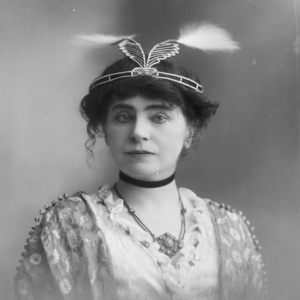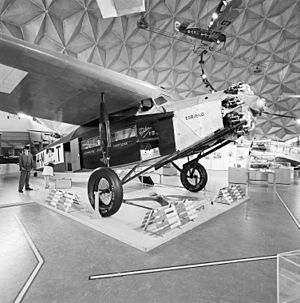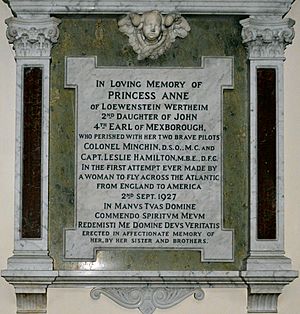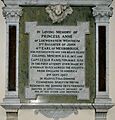Princess Anne of Löwenstein-Wertheim-Freudenberg facts for kids
Quick facts for kids
Princess Anne of Löwenstein-Wertheim-Freudenberg
|
|
|---|---|

in 1913 by Bassano
|
|
| Born |
Lady Anne Savile
25 May 1864 London, England
|
| Disappeared | 31 August 1927 (aged 63) North Atlantic Ocean |
| Status | Declared dead in absentia, 6 February 1928 |
| Monuments | Memorial at St Raphael's church, Kingston upon Thames |
| Nationality |
|
| Known for | First woman to attempt transatlantic flight and first woman to die in transatlantic flight. |
| Spouse(s) |
Prince Ludwig of Löwenstein-Wertheim-Freudenberg
(m. 1897; died 1899) |
| Parent(s) |
|
Princess Anne of Löwenstein-Wertheim-Freudenberg (German: Anne Prinzessin zu Löwenstein-Wertheim-Freudenberg) was an English lady who loved flying. She was born Lady Anne Savile on May 25, 1864. She became a princess when she married Prince Ludwig of Löwenstein-Wertheim-Freudenberg. Anne was the second woman to try and fly across the Atlantic Ocean. Sadly, she was also the second woman to die during such a flight.
Contents
Early Life and Marriage
Anne was born in London, England, on May 25, 1864. Her father was John Savile, the 4th Earl of Mexborough. Her mother was Agnes Louisa Elizabeth Raphael.
In 1897, Anne married Prince Ludwig of Löwenstein-Wertheim-Freudenberg in London. After their marriage, she became a citizen of Germany. Anne was very wealthy, and she brought a large fortune to her marriage.
Sadly, her husband Ludwig disappeared less than a year later. He was in the Philippines during the Spanish–American War. He was killed during a battle between American soldiers and local fighters. Anne was told about his death by the United States Embassy in London. After World War I ended in 1918, Anne became a British citizen again.
An Inventor's Idea
Before World War I, Anne often visited the United States. In 1913, she arrived in New York City on a ship called the SS Majestic. She brought with her a special "automatic balancing bed" that she had invented. Anne believed this bed could stop people from getting sea sick on ships.
A Passion for Aviation
Anne started flying as a passenger in airplanes in 1914. She became good friends with Captain Leslie Hamilton. He was a famous pilot from World War I, known as the "Flying Gypsy." Anne often flew with him in air races. When she flew, she usually used her maiden name, "Lady Anne Savile."
In 1922, Anne rode in her own airplane during a race from Croydon to Edinburgh, Scotland. In 1925, she and Captain Hamilton tried to fly from London to Paris. Their plane had engine trouble and had to land near Pontoise, a town near Paris. They were found after an all-night search.
The Transatlantic Flight
In 1927, Anne decided to help Captain Leslie Hamilton. She paid for his attempt to fly across the Atlantic Ocean from east to west. This meant flying from England to Canada. Even though her family, including her brother, tried to stop her, Anne decided to join the flight as a passenger. She had always dreamed of being the first woman to "fly the sea."
On August 31, 1927, Anne, Captain Hamilton, and Colonel Frederick F. Minchin took off. They flew from an aerodrome in Upavon, Wiltshire, at 7:32 a.m. Their plane was a large Fokker F.VII called the Saint Raphael. It had a powerful 450 horsepower engine. They were headed for Ottawa, Canada.
For this historic flight, Anne wore a special outfit. She wanted to show what women should wear for a transatlantic flight. She had purple leather pants, a matching jacket, and fur-lined boots. Before they left, a religious leader blessed the airplane and its crew.
Disappearance and Legacy
The Saint Raphael flew west from the coast of Ireland. It was last seen by the crew of a ship called the SS Josiah Macy. The next morning, another ship reported seeing a light in the sky far from their planned route. If it was the Saint Raphael, it meant they were lost.
The airplane was never seen again. People searched for the plane and its crew, but they found no trace. Anne's brothers believed she had died at sea with Captain Hamilton and Colonel Minchin. It is thought that they all died on August 31, 1927, in the North Atlantic Ocean.
At the time of her death, Anne was the second woman to disappear trying to fly across an ocean in just two weeks. The first was Mildred Doran, who disappeared during a race to Hawaii.
In 1928, many lakes in Ontario, Canada, were named after aviators who died in 1927. One lake, St Raphael Lake, was named after the Saint Raphael airplane. Other nearby lakes were named Hamilton Lake, Minchin Lake, and Wertheim Lake, which honors Princess Anne.
A large memorial plaque for Anne, Captain Hamilton, and Colonel Minchin hangs in St Raphael's Church, Surbiton.
Images for kids
See also
 In Spanish: Princesa Ana de Löwenstein-Wertheim-Freudenberg para niños
In Spanish: Princesa Ana de Löwenstein-Wertheim-Freudenberg para niños





